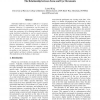Free Online Productivity Tools
i2Speak
i2Symbol
i2OCR
iTex2Img
iWeb2Print
iWeb2Shot
i2Type
iPdf2Split
iPdf2Merge
i2Bopomofo
i2Arabic
i2Style
i2Image
i2PDF
iLatex2Rtf
Sci2ools
HICSS
2002
IEEE
2002
IEEE
The Relationship between Scene and Eye Movements
Individual differences make it difficult to recognize similarities between individuals in eye movement patterns. However, if consistencies can be found, eye movements could be used for a variety of purposes. In this study, the consistency of eye fixation patterns is explored using statistical evaluation as well as neural networks. Eye tracking data is used as input units into neural networks to test whether they can learn to associate task patterns with that task data. A network is successfully used to determine whether a participant was searching text on the screen or counting groups of arrows from eye fixation information. Another network is trained to determine whether the participant was counting a group of 1-3 arrows or 4-6 arrows, as would be expected according to the tendency to “subitize,” or recognize small numbers of objects without counting each of them. The implications of the findings are discussed.
| Added | 14 Jul 2010 |
| Updated | 14 Jul 2010 |
| Type | Conference |
| Year | 2002 |
| Where | HICSS |
| Authors | Laurel King |
Comments (0)

